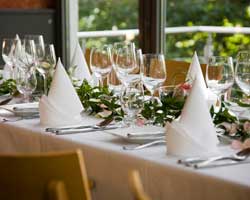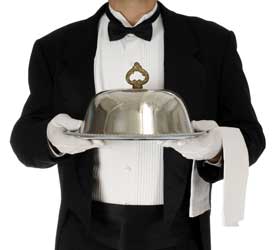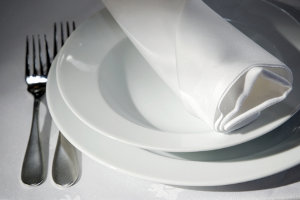Napkins
» About Napkins

Today, discriminating hosts and hostesses have a wide variety of napkin products from which to select. For formal dining, there is the cloth napkin, the paper napkin being reserved for more informal settings.
The theory, evidently, is that the more food and drink that is served, the more potential there is for spillage, so the bigger the napkin must be to catch it.
Cloth napkins may be purchased in a rainbow of colors and a variety of fabrics.
» Napkin Etiquette

Whether the napkin is cloth or paper, when in polite company, a napkin is to be used with a measure of etiquette, so as not to offend other diners through a display of boorishness. (You’re excused from these rules only when the napkin you are offered is one of those flimsy little paper things that pop out of tabletop dispensers – the kind of “napkin” you cannot place on your lap expecting it to not blow away within 20 seconds; even here, however, try to keep boorish behavior in check.)
Rule 1: When you’re given a napkin, use it. Don’t let it sit beside your plate. It was given to you for wiping your face when you need to and to protect your lap from spills. Leaving it beside your plate marks you as a slob.
Rule 2: Wait for the host to pick up and unfold his napkin before you do the same with yours.
Rule 3: If the napkin is larger than your lap, fold it such that it just covers your lap.
Rule 4: In polite society, movements at the dinner table tend to be small, so don’t make any ostentatious displays like wildly shaking the napkin to open it. Just unfold it. And when you wipe your mouth, don’t use the napkin as you would a wash cloth during your morning shower; gently dab at your mouth.
Rule 5: Don’t wait for the food to be served before you open your napkin. Should your napkin still be sitting on the table when the food arrives, the server may have to create space to set your plate.
Rule 6: Should you have to leave the table during the meal, leave the napkin, loosely folded, on your seat or on the table to the left of your plate. Also put the loosely folded napkin to the left of your plate when you’re done eating, never on the plate.

Rule 7: The place for a napkin? In your lap. It is not tucked into your pants, nor does it belong tucked into your shirt collar. However, if you are in a milieu where that kind of behavior is acceptable, don’t be afraid to go along. For example, diners from Southern Italy (or southern New Jersey) have long known that a bowl of spaghetti topped with marinara sauce can be better enjoyed when you don’t have to worry about the red stuff splattering on your shirt. Many Italian and Italian-American diners therefore tuck the napkin into their collars as a matter of course. Feel free to do the same. Live! Enjoy!
But what about that waiter who carries a napkin draped over one arm? In part, it’s practicality. It’s readily available to mop up any accidental spills or other messes at your table. But the practice dates back a couple of hundred years in France; that was how waiters carried the napkins they would distribute to diners. Napkins have been in use for thousands of years.
It’s possible that cavemen at their wooly mammoth barbeques wiped the grease from their mouths using the animal’s pelt... and then rubbed it in their hair to get that suave, slicked-back look. But we don’t really know that. What we do know is that, by the Bronze Age, it’s likely something like a napkin was in use in many parts of the world. The first recorded use of the napkin was by the Romans. When that hearty eater, Buffetus Allucaneatus, reached for his napkin at the Roman dinner table, he didn’t find a cloth. What he used was some wadded up unbaked dough, which he pressed to his face. That removed whatever bits and morsels of food were sticking to it. Later, if he wished, he could bake and eat his napkin, morsels and all.

With the fall of Rome, Europe entered that slovenly, napkin-less period of the Dark Ages, with its uncouth barons and unwashed princesses wiping their hands on their tunics and mopping their faces with their shirttails and cuffs. We don’t know how knights encased in steel armor managed to wipe off their mouths.
By the time of the Renaissance, the French had a single, large communal napkin about the size of a table cloth which everyone at the table used. It may have been the precursor of the table cloth. It got smaller and smaller over the years until everyone had his own napkin. By the 1700’s, the French aristocracy had even promulgated rules of napkin etiquette, some of which we still use today throughout the Western world; e.g., we don’t blow our nose into our napkin. Or anyone else’s napkin, either.
